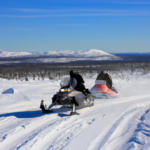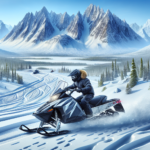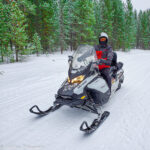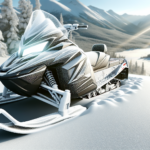Embarking on the thrilling world of snowmobiling might leave you with one looming question: what size snowmobile should I get? This article will guide you through selecting the perfect size for your snowmobiling adventure. It’s all about balancing your physical dimensions, riding style and experience level. You need a machine that matches not only your stature but your skills in the snow. Let’s explore how you can make the best choice and ensure an exciting and safe ride.
Understanding Types of Snowmobiles
Before deciding on what size of snowmobile you should get, it’s crucial to understand the basic types of snowmobiles. Skimming the surface or barreling through deep powder requires not just skill, but also the right equipment.
Basic Types of Snowmobiles
There are three basic types of snowmobiles: touring, performance, and mountain sleds. Touring sleds are designed for long rides over smooth trails, featuring plush suspensions and comfortable seating for two. Performance sleds are fashioned to tear up a snow-covered landscape at respectable speeds. Mountain sleds, on the other hand, are lightweight, nimble, and designed for deep snow and vertical terrain.
Intended Usage of Each Type
Each type of snowmobile has a unique purpose. The touring snowmobile is for extended trips across well-marked trails. For those who like speed, the performance sled is your go-to snowmobile. And if you enjoy carving your path through deep and untracked snow, a mountain snowmobile is perfect for you.
Factors Determining Snowmobile Size
You’ve got a grasp on the types of snowmobiles and their usage, now let’s talk about the various elements that determine the size of a snowmobile you should choose.
Rider’s Experience Level
Your riding experience plays a significant role in determining the optimal snowmobile size. Beginners usually start with smaller sleds, while experienced riders often prefer larger and more powerful models.
Rider’s Body Size
Your physical size is equally important in deciding the appropriate snowmobile size. Riders need to be able to manage the weight and size of their sled effectively, supporting secure riding and comfortable maneuverability.
Trail or Off-Trail Riding
The snowmobile size also depends on whether you plan to ride trails or off-trail. Trail riding typically calls for smaller snowmobiles while off-trail riding may require a larger model with a longer track to navigate deep powder.
Anticipated Snow Conditions
Snow conditions tremendously influence the choice of snowmobile size. Deeper, fluffier snow often requires a larger sled with more flotation, while groomed trails can be managed with smaller, more compact sleds.
Snowmobile Size and Rider’s Experience Level
Beginner Level Riders
For novice riders, smaller snowmobiles are the best fit. A compact sled is typically easier to handle and control, providing a safer riding experience for those still learning.
Intermediate Level Riders
For those with intermediate riding capabilities, a mid-sized snowmobile usually provides the best mix of power and maneuverability. These riders have enough experience to handle a larger machine but are not yet comfortable with the power of a performance model.
Expert Level Riders
For expert riders, larger, high-performance snowmobiles are typically the best choice. These machines offer superior speed and power, but they also require the skill set to manage and control them.
Snowmobile Size and Rider’s Body Size
Importance of Weight in Snowmobile Control
Weight plays a crucial role in controlling a snowmobile. Heavier riders need a larger machine to account for the additional weight and to retain control, while lighter riders may find a smaller machine more manageable.
Snowmobile Size for Smaller Riders
Small riders should opt for smaller snowmobiles. These riders are less likely to manage the weight and size of larger sleds comfortably, potentially making the riding experience tiring or even dangerous.
Snowmobile Size for Larger Riders
On the flip side, large-bodied riders will benefit from larger sleds. These snowmobiles are designed to distribute weight more evenly, helping to maintain stability and control while riding at high speeds or in challenging terrains.
Snowmobile Size for Trail Riding vs Off-Trail Riding
Trail Riding Snowmobile Size Considerations
For trail riding, a smaller snowmobile is usually your best bet. These sleds are designed to be agile, making them easier to control on groomed trails. The machine’s width plays a significant role: narrower snowmobiles typically provide better control on trails.
Off-Trail Riding Snowmobile Size Considerations
Off-trail riding, on the other hand, often calls for larger snowmobiles. These machines have longer tracks and are generally wider, providing better flotation in deep snow. They also have superior traction to help in climbing steep inclines or navigating difficult terrains.
Snowmobile Size and Snow Conditions
Size for Light Snow Conditions
Light snow conditions typically call for a smaller and more manageable snowmobile. These conditions don’t offer much resistance, and so a more compact sled can swiftly navigate the terrain.
Size for Heavy Snow Conditions
In heavy snow conditions, a larger snowmobile is usually necessary. The added size offers more flotation, ensuring the sled doesn’t just sink into the deep snow. Longer and wider tracks designed for these conditions provide better grip and control.
Narrow vs Wide Snowmobiles
Advantages of Narrow Snowmobiles
Narrow snowmobiles provide several benefits, particularly in terms of control. These sleds are easy to tip, which comes handy when carving turns on groomed trails.
Advantages of Wide Snowmobiles
Wide snowmobiles may be more difficult to tip, but they provide superior stability and flotation, particularly in deep snow conditions. They enable you to navigate your way without sinking into the snow, a valuable characteristic when off-trailing.
Long vs Short Track Snowmobiles
Benefits of Long Track Snowmobiles
Long track snowmobiles offer excellent flotation and stability, making them ideal for handling deep snow or off-trail riding. They keep the machine on top of the snow, preventing your sled from getting bogged down.
Benefits of Short Track Snowmobiles
Short track snowmobiles, however, provide swift response and greater control, making them ideal for groomed trails and hard-packed snow conditions.
Understanding Snowmobile Specifications
Engine Power and Size
Engine power and size saddle up together when choosing a snowmobile. Larger engines provide more power, which can be a benefit or a hindrance depending on your experience level and the terrain.
Chassis and Suspension Design
The design of a snowmobile’s chassis and suspension also play a significant role in its performance. A well-tuned suspension system can absorb impacts, making your ride smoother, while a well-designed chassis can significantly improve handling.
Getting the right size – Practical Tips
Test Riding Different Sizes
Nothing beats firsthand experience. Test riding various snowmobile sizes can give you a feel for what size is suitable for you. Make sure to try different models in an assortment of terrain and snow conditions.
Making an Informed Purchase
Always research before purchasing your snowmobile. Gather information through online reviews, forums, and by talking to fellow riders. They can provide useful insights into the best brands and models to suit your needs.
Adjusting the snowmobile to fit you
Finally, remember that most snowmobiles are adjustable to some extent. Taking the time to tune your ride to your preference can make a significant difference, providing you with a more comfortable and pleasant riding experience.
In conclusion, the best size of a snowmobile for you is determined by many factors such as your physical size, experience level, riding style, and snow conditions. Always ensure every aspect is considered before making a purchase to get the most from your snowmobile experience. Happy riding!
- What Snowboard Bindings Should I Get? - January 23, 2024
- What Size Screws For Snowboard Bindings? - January 23, 2024
- How To Snowmobile On Water? - January 23, 2024










